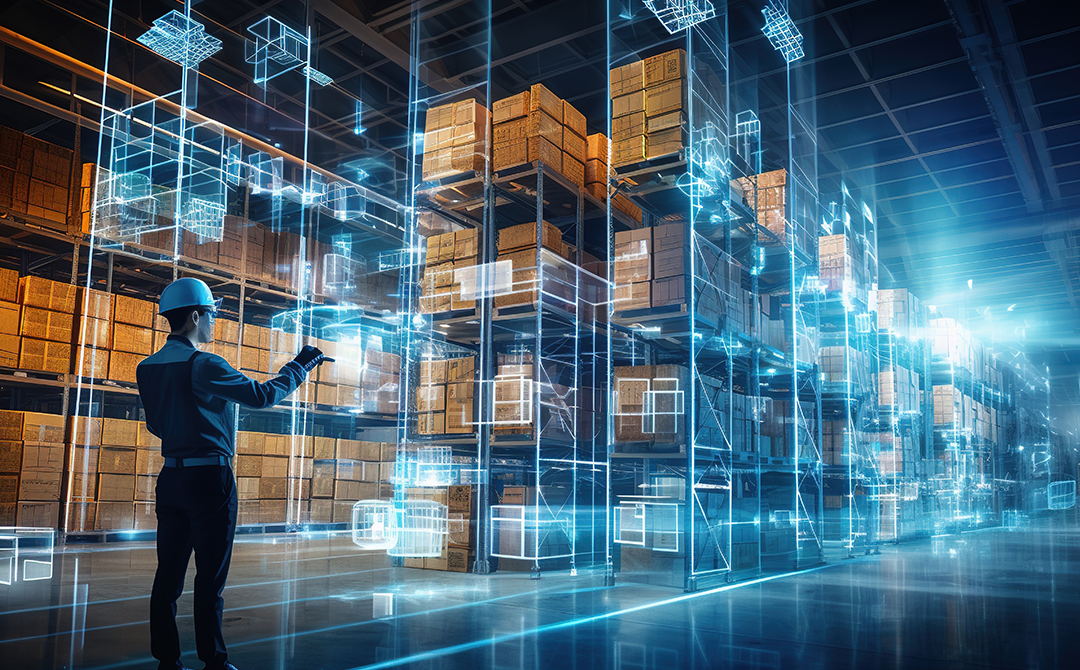
Chief Supply Chain Officers (CSCOs) today face a barrage of supply chain disruptions that threaten to erode their company's competitive edge. Some of the disruptions commonly include geopolitical shocks, volatile demands, and ever-evolving customer expectations. Traditional AI and legacy systems, though helpful, can no longer deliver the agility and resilience modern supply chains demand.
This is where Generative AI steps in to empower CSCOs to anticipate risks and automate complex supply chain operations. With this tech, they move beyond reactive firefighting to proactive orchestration, ensuring their supply chains not only survive but thrive in dynamic markets. Generative AI offers innovative ways to optimize operations and adapt to changes. And in this blog, we will explore the role, the potential of generative AI, and real-world applications of generative AI in modern supply chains.
What is generative AI, and how does it differ from traditional AI in supply chain management?
Supply chains have long used traditional artificial intelligence (AI) as a part of their automation to improve employee productivity and the efficiency and accuracy of critical processes such as supply chain planning, demand forecasting, lead times, and inventory management. Tools like decision trees and statistical models perform pre-set tasks that comprise these processes very reliably based on learnings from historic data sets.
However, navigating current supply chain volatility requires more than automation and fixed learning. Next-generation generative AI (Gen AI) with its ability to support innovative, live strategizing based upon near-real-time insights, can provide the responsiveness supply chain teams today need and is rapidly emerging as the cutting-edge problem-solving tool of the hour. Generative AI solutions are becoming integral in addressing these challenges.
Generative AI stands tall over traditional AI
Generative AI supply chain models like natural language processing (NLP) and graph analysis learn on the fly from live data streams and create new content in formats that are easy for teams to understand and apply. Generative AI and machine learning have one more key advantage over traditional AI. From numbers to reams of text and images, it is not limited by data types and sources and can effortlessly scan massive volumes of diverse structured and unstructured data fast for inputs. These powerful abilities that distinguish gen AI from other analytics engines can help supply chain teams shatter data and communication barriers throughout their ecosystem.
Half of supply chain leaders plan to implement generative AI in their supply chains within a year. CSCOs are dedicating 5.8% of their function’s budget, on average, to generative AI.
Source: Gartner
Real-world applications of generative AI in supply chain management: Improving stakeholder relationships
The effectiveness of a supply chain depends on the quality of its relationships with diverse stakeholders across numerous ecosystems, contributing to overall supply chain efficiency. Financial service organizations, regulatory bodies, multinational retailers, and small and medium-scale suppliers are all equally important partners.
Supply chain leaders and their teams have to work with FSIs for trade finance, cooperate with regulatory bodies for reporting and compliance, and identify suppliers, retailers, and logistics partners who comply with local, cross-border, and internal regulations that span business and ESG dimensions, and build strong relationships with them.
While large organizations have automation and traditional supply chain AI in place to help teams with these activities, generative AI applications in supply chain can significantly enhance these efforts.
Generative AI in supply chain involves tools such as LLMs and Reinforcement Learning (RL) agents to scan the latest updates on a range of influencing variables, such as business and ESG regulations, legal frameworks, and the reputational history of a partner, and create new approaches on the go. This capability can empower both supply chain teams and their ecosystem partners during key negotiations and conversations and also help in the accurate drawing up of contracts and reports.
Graph Neural Networks (GNNs) can help supply chain analytics teams proactively identify potential areas of non-compliance so they can rapidly alter internal mechanisms or alert external partners and avoid serious regulatory and reporting concerns.
In this way, generative AI in supply chains supports every single process that drives relationships between the supply chain team and external stakeholders with accurate, well-researched, and contextual information and recommendations, leading to frictionless, long-standing trust-based equations. Generative AI services ensure that these interactions are smooth and productive.
In a recent successful application, a US retailer built a generative AI-led bot to conduct negotiations with its vendors, and over 65% of vendors found that they preferred dealing with the bot over humans. The technology’s ability to rapidly grasp complex discussion points and marry them with facts and processes to propose several alternative scenarios is likely to have led to this preference.
Boosting resilience
Supply chains in large companies are vast, complicated international networks spanning thousands of suppliers, distributors, retailers, and numerous owned and contractor manufacturing plants. Since the multidimensionality of the challenges to the reliability of this interconnected network is growing in tandem with its complexity, the abilities of existing decision-making engines, such as traditional AI, are proving inadequate for unlocking the value of AI in proactive risk mitigation.
However, generative AI digital supply chain models, which can ingest the varied causative historical data and provide multiple, granular strategies on the go, can help effectively address current, real-time supply chain visibility challenges.
For instance, NLP techniques can use social media sentiment analysis to predict customer demand or weather forecasting alerts to spot likely logistical disruptions. Simulation models can mimic the impact of real-world disruptions (e.g., delayed shipment, sudden demand surge) and provide live recommendations for mitigation.
Outlier detection can identify anomalies and potential disruptions in real-time data streams, like unexpected traffic congestion or social media buzz around product safety concerns. Additionally, generative AI in supply chain management can synergize with the digital twins to test and optimize responses to potential disruptions.
Currently, a global CPG leader uses NLP models to draw data from social media, news publications, and information bureaus to determine the real-time impact of extreme weather, port congestion, traffic, and socio-political happenings on its supply chain, similar to studies conducted by the Boston Consulting Group. This has delivered 78% stock-out prediction accuracy and saved the company nearly $90 million in losses.
Enhancing Employee Satisfaction and Collaborative Innovation
Employee satisfaction leads to customer satisfaction. And with seamless digital experiences in their personal lives, employee expectations are now rising. It is no different with generative AI solutions. Empowering supply chain teams with the technology will boost morale, unlocking far more than efficiency and cost savings.
Since generative adversarial networks (GANs) and generative AI’s advanced capabilities can support the existing automation of daily activities like invoicing, drawing up contracts, credit notes, estimates, and order placement with real-time updates to function more accurately and speedily across various applications, this will free up employees for strategic decision making and innovation in customer service.
Since genAI learns dynamically, it will also spot new and dangerous fraudulent activity faster than current technologies and practices, saving time and money and significantly reducing worry for supply chain teams. Generative AI services from leading providers help build cross-disciplinary capabilities to enhance user experience (UX) design, model development, governance, change management, and ongoing managed services.
Crucially, when employees utilize the time freed up by generative AI for upskilling or innovation, the technology can be a very helpful co-pilot, thanks to its growing accessibility in recent years. Supply chain teams can leverage the user-friendly interfaces of gen AI tools, creative content generation and data analysis to:
- Upskill themselves continuously, learning new skills and adapting to evolving trends in supply chain management and data analysis.
- Create collaborative lab and CoE scenarios to rapidly and continuously build value-added innovation that will improve processes and profitability.
Top multinationals have recognized that generative AI applications will motivate supply chain teams to transform the supply network into an innovation engine with a competitive edge and are setting up labs to explore the powerful combination of generative AI and human ingenuity.
Current adoption trends of generative AI in supply chains and who's leading the way?
Currently, Gartner has found that the most impactful generative AI use cases in supply chain transformation include various use cases such as code augmentation, providing more insights into supply chain KPIs, and staff assistance chatbots. In addition to materials and goods-intensive sectors like retail, e-commerce, manufacturing, and logistics, knowledge-focused sectors like healthcare are also leveraging the technology for their critical supply chains.
Since the supply chain lags other business functions in gen AI adoption, it can convert this into an opportunity by capitalizing on the early learnings and technology investments of other teams like marketing and sales, Gartner advises.
Proving Value: How to Measure the ROI of Generative AI in Supply Chain
It's no secret that CSCOs need to demonstrate tangible business value and clear returns when justifying investments in new technologies like generative AI. Traditional ROI metrics usually fail to capture the full impact of these advanced technologies, further demanding a more tailored and nuanced approach:
Identifying tangible and intangible benefits
This not only involves efficiency gains and direct cost savings, but also strategic outcomes like improved customer satisfaction, a profile of your interests, enhanced agility, and workforce capacity.
Tracking operational metrics
This focuses on quantifiable improvements such as time saved through automation, reductions in inventory carrying costs, and decreased error rates in document handling, order processing, and logistics. Stockouts are also determined through AI-driven demand forecasting and inventory optimization.
Assessing strategic and capability ROI
The main question that arises here is whether generative AI can support broader business functions too, outside of just supply chains. Through scenario modeling and real-time analytics, supply chain leaders can analyze how far the company adapts to market changes and disruptions. They can also assess an employees' skills and technological maturity, developing a culture of innovation.
Calculating financial ROI
This is where CSCOs have the opportunity to prove what generative AI is capable of in terms of financial returns. Using a customized ROI framework that aligns with the organization's AI strategy, the following metrics are calculated:
- Total cost of ownership (Involves implementation, training, and integration costs), including potential considerations from third party providers.
- Value of productivity gains, cost reductions, and incremental revenue.
- Non-monetary benefits such as improved supplier relationships, sustainability outcomes, and even improved goodwill.
Potential obstacles in implementing generative AI in the supply chain?
A few critical points need to be kept in mind during generative AI adoption for supply chains. Since these generative AI models, including large language models, run on data within and outside the organization, and reformulate learnings on the go, a thorough understanding of the models used, which includes addressing the most important challenges like any potential bias and ethics concerns, as well as the local, global, and organizational security and privacy norms, is non-negotiable. Since models are only as good as what goes into them, data quality cannot be ignored.
Preferably, these models should not be 100% off-the-shelf but built or customized in partnership with consultants with a nuanced understanding of Gen AI, the supply chain domain, and expertise in change management during the adoption phase, including monitoring the global supply chains as they evolve and facilitating strategic decisions.
Finally, supply chain teams and their IT partners must avoid reinventing the wheel in their enthusiasm to leverage Gen AI for efficiency and innovation. Embracing Gen AI will bolster competitive advantage and be much faster in creating impact and positive RoI when it starts off as an additional layer to augment the existing rules-based AI and automation and as a collaborator for innovation.
FAQs
1] What are some examples of generative AI use cases in supply chain management?
Generative AI use cases in supply chain include demand forecasting, inventory optimization, logistics, route planning, supplier risk assessment, etc.
2] Is generative AI only useful for large, complex supply chains?
No, generative AI can benefit supply chains of all sizes by improving efficiency, forecasting, and decision-making even for smaller supply chains.
3] Can generative AI improve sustainability in supply chains?
Yes, it can enhance sustainability by optimizing routes, reducing emissions, and tracking ethical sourcing.
4] What should I look for in a generative AI supply chain solution provider?
Look for supply chain providers with proven industry expertise, robust data integration capabilities, scalable AI models, and strong security and compliance standards.
5] Can generative AI help forecast demand more accurately?
Yes, generative AI analyzes vast data sources and complex patterns to generate more accurate and adaptable demand forecasts.

AUTHOR - FOLLOW
Editorial Team
Tredence
Topic Tags




